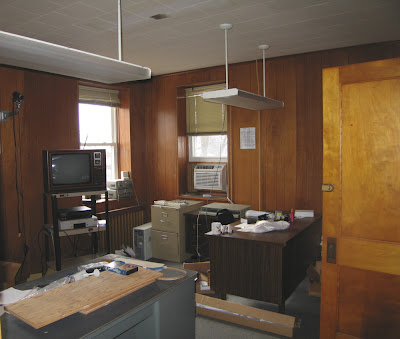The reassuring thing about Lucas County’s old jail/sheriff’s residence, placed last week by Preservation Iowa on its top-ten list of endangered historic Iowa buildings, is that it’s in such good shape. Figuring out how to creatively recycle in trying economic times an obsolete jail built like a bunker is the challenge.
Four of us, including an engineer, did a walk-through Wednesday. None of us had been in jail before --- at least not this one --- so it seemed like a good idea to take a look at a building we’ll be talking about quite a bit this year.
The fact that the old jail is in the shape it’s in is a tribute both to the guy who built it in 1916, contractor Andrew Jackson Stephens, and to the county, which has maintained and reinvented it during the last century.
As designed, the south part of the building was intended to house the sheriff and his family --- the sheriff’s wife, back in the day, would have cooked for prisoners and supervised laundry, cleaning other tasks.
This area, two full stories above a high, dry and well-lighted partially-finished basement, has served for many years as the county law enforcement center, housing both the Lucas County Sheriff’s Department and Chariton Police Department.
These offices were moved to the new Law Enforcement Center last fall and, if the heat, water and power were turned back on, it looks as if another agency could move right in. A little cleaning would be needed, since furniture and equipment not needed in the new LEC, as well as a good deal of rubbish, was left behind. A good stairway, oak-railed from first to second, connects all three floors.
The north half of the building was designed as a jail, and still is --- although extensively adapted over the years. Here, a cast-iron open stair, caged at the top, climbs from basement to the second floor. The thickness of the reinforced concrete basement walls is extraordinary.
Originally, cells and holding areas in the jail would have been configured differently and lighted by barred windows. With a couple of exceptions on the stair, these windows have been bricked up over the years and so there is no natural light now in the main cellblock or cells intended for women and juveniles. The main first-floor cellblock, individual cells around a common area, is new when compared to the rest of the building, created within the original shell with concrete block and steel doors. The second-floor area above the cellblock is a large open day room.
This would be the most challenging area to recycle, considering all that concrete, cast iron and steel, but certainly could be done. As is, the jail would make an excellent secure storage facility. If some of the windows were re-opened, innovative workplaces might be possible.
While we didn’t probe and poke extensively, there were no signs of structural deterioration inside the building. The condition of the roof has been a topic of conversation and there are a few stains on second-floor ceilings to that indicate leaks have occurred. But there were no signs of catastrophic failure.
Walk around the outside of the building and you notice places where repairs to the brick work have been necessary over the years. The only major cause for concern right now, however, is at the northeast corner of the building where a drain pipe from the trough that drains the roof has vanished, allowing water to trickle down the side of the building. That can be disastrous for a brick structure, but also could be easily corrected.
Currently, all utilities have been disconnected and the building is not heated. One season of this should be OK, but after that deterioration will start, then accelerate.
It’s always entertaining to think about what you might do with a building of this sort. Location --- right along Iowa’s busiest rail line --- is a challenge. Rail traffic has not affected the structural integrity of the building nor is the sound of passing trains that intrusive. The train whistles at the crossing adjacent to the jail property, however, are very loud.
It would make a good courthouse annex, if such were needed, offering plenty of storage space to officials who need it.
And I keep thinking of two extraordinary examples of business-related creative recycling already in place in Chariton --- McKinley, Inc., headquartered in the former Garfield School, and Johnson Machine Works, which more recently has converted two attached rail-side buildings into highly innovative headquarters for its drafting department.
The great advantages of turning jail cells into offices, of course, would be that supervisors could ensure workers remained at their desks --- and each office would have its on executive toilet.
That’s probably the sort of thinking that’s needed. Now if I just had a spare million or two gathering dust …












No comments:
Post a Comment